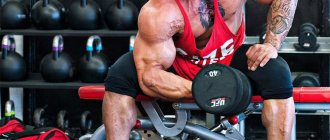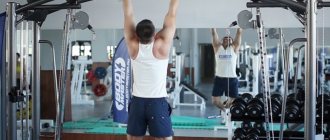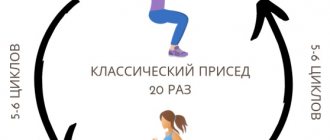Bodybuilding is primarily about building muscle mass and reducing the amount of fat in the body. Training to increase mass will be different from those used to increase strength and endurance. The set of exercises, the number of sets and repetitions, rest between approaches - all this needs to be planned before starting regular training. If there is no program, then you are not training to gain muscle mass, but doing physical exercise to maintain tone.
Training program for gaining muscle mass 5x5
Sports nutrition and supplements. Where to begin?
Nutrition program for gaining muscle mass
Most gym goers train according to the Split Program - 3 days a week, each time working out 1-2 parts of the body (back and triceps; chest and biceps; thighs, buttocks and calves).
The split program combines exercises:
- basic – involving many muscles at the same time (Barbell Press, Squats, Deadlifts)
- isolated - aimed at working out any one muscle (biceps curls, leg curls in the simulator, crunches)
The strength training program consists mainly of heavy basic exercises and almost does not include isolated ones.
What is split training
Split training is used by advanced bodybuilders, for whom the load is no longer enough to maximally pump up all the muscles. Then the split technique comes to the rescue, reducing the overall volume of training, but increasing the intensity of the load on individual muscles.
Unlike other bodybuilding training programs, split is good because it gives muscles more time to rest and recover. This, in turn, increases growth potential. If you exercise according to the classical scheme, muscle growth may be inhibited due to banal overwork. Muscle tissue simply does not have time to return to normal.
Beginners or athletes after a long break should not start training with a split. Due to lack of experience and insufficient muscle strength, isolated work does not provide the required increase in volume. At the same time, the nervous system gets tired faster, joints and ligaments are heavily overloaded, as they are not prepared. Over time, the novice athlete will become more experienced, the muscles will adapt to the load and changes will be required in the bodybuilding training program. In this case, using split will be relevant.
System advantage
As mentioned earlier, when creating a training regimen, a good split program allows you to include all major muscle groups in your workouts.
Proper organization of periods of stress and rest allows the body to repair damage to tissues and accumulate strength. This has a good effect on the hormonal background and the speed of progress of the athlete.
Individual characteristics
The options for three-day schemes are varied, but, as a rule, they all follow the same principle: muscles are divided into “pulling” and “pushing”, and a separate group is worked out in each training session.
When choosing a suitable training system, many factors are taken into account, among which the most important are:
Gender of the athlete.
Split training for representatives of the stronger half can be very different from the women's program. This circumstance is primarily due to the different anatomy of the muscle corset and the different biochemical composition of the blood. Among other things, training has different goals. Ladies, in most cases, try to get rid of extra pounds and achieve a beautiful body contour in order to look even more impressive. And the three-day split in the male version is, first of all, a concern for creating a beautiful figure that shows muscles. Representatives of the stronger sex use exercises to make their biceps “lumpy”, complementing them with the “building blocks” of the abs.

Degree of preparation. A beginner should not overestimate his own capabilities and switch to split training in the very first days. Experts unanimously say that you should first pump up all muscle groups as a whole. This method will allow the body to develop evenly, gradually increasing endurance and strength.
And only after reaching certain “heights” does it make sense to approach split exercises, that is, devote time and attention to each muscle group separately
Body features.
People, in general, from the point of view of bodybuilding training can be divided into three groups: ectomorphs, endomorphs, mesomorphs. Depending on whether you belong to one type or another, the speed at which you improve your body and build muscle mass changes. Therefore, the approach to organizing training should be significantly different.
Dependence of the training plan on body type
Ectomorphs
Tall, very thin men with long and thin limbs often have a huge number of complexes and, at times, not very good posture. Such people have difficulty gaining weight because they have a good metabolism. But correctly selected techniques will allow you to quickly turn such “disadvantages” of your build into significant advantages, since a tall, “pumped up” and moderately thin young man looks great. A three-day split for people of this type should be selected taking into account the following recommendations:
it is necessary to pay sufficient attention to basic exercises; training time should not be more than 45 minutes; exercises are repeated 6-8 times, and the number of approaches should be from 4 to 6. The rule “the more, the better” is not for people of this type.
Mesomorphs
Such people have muscles developed from birth, they have a wide chest and a long torso. Muscle mass responds to exercise excellently, increasing proportionally. It is much easier for men of this type to form beautiful relief. In this case, split training should take into account the following rules:
- repeat each exercise 8-10 times, with the number of approaches ranging from 6 to 8;
- it is allowed to include special exercises in the training that can help improve muscle shape;
- Each session is recommended to work 2-3 muscle groups.
Endomorphs
People who are prone to being overweight usually accumulate pounds in the hips and abdomen. Such a “non-athletic” figure, first of all, should be put in order. Endomorphs require training designed taking into account the following conditions:
- heavy physical exercise at the beginning of classes. They should ensure the burning of excess calories and the growth of muscle mass.
- minimum rest time between approaches (no more than a minute or one and a half);
- The duration of each workout is one and a half to two hours.
Taking into account all these recommendations, there is one “but” - the development of an individual complex (as a rule, the Monday-Wednesday-Friday regime is taken as a basis) is better based on the recommendations of a competent instructor. This nuance is especially important for those who are just starting to engage in bodybuilding, since without additional consultations and advice you can, as they say, “break the woods.”
Which exercises to choose
Before creating a split program, you need to understand that depending on the goal of the workout, the number of approaches and repetitions may vary.
When training for strength, basic movements should be done with weights that you can lift a maximum of 5 times.
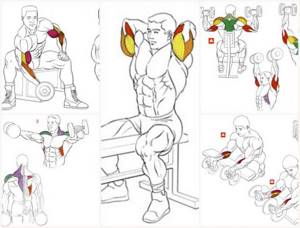
At the same time, you need to give it your all and spend 90% of your energy on them. The secondary ones are finishing, finishing and cool-down.
Gaining muscle mass should be aimed at maximizing damage to the smallest fibers. After restoration, they will become stronger and thicker.
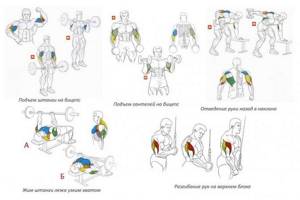
The totality of each thickening leads to noticeable muscle growth. Heavy weights are suitable for this purpose, but with repetitions up to 8-12 times. In this case, more attention is paid to secondary exercises.
The development of muscle endurance is achieved through two mechanisms: improved innervation and an increase in the supply of glucose in the muscles. This can be achieved by performing high-repetition exercises with medium weights.

The number of repetitions should reach 15-20 times. In addition, you can use more approaches and different movements.
Creating a split program for a week requires that:
- Most muscle groups were included.
- There were basic and secondary exercises.
- Before the next workout, the muscles must fully recover.
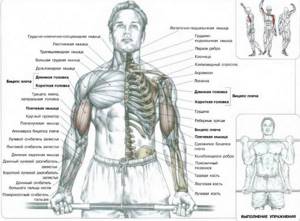
Fulfillment of these requirements will lead to the process of activating the supercompensation mechanism. It consists in the complete restoration of damaged tissue areas, with an increase in the mass and strength of the latter.
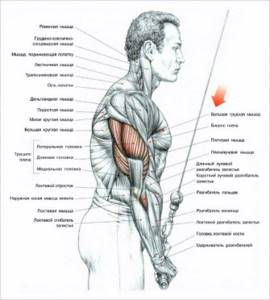
Mass training program 4 times a week
Monday: chest and triceps
- Bench press: 4 sets of 8-12 reps
- Incline Dumbbell Press: 4 sets of 8-12 reps
- Trapezius exercises: 3-4 sets of 8-12 reps
- Back swings through emphasis on bent arms: 4 sets, repetitions - as far as possible
- Triceps extensions (cable arm extensions, cable arm extensions): 4 sets of 8-12 reps
- Triceps extensions (cable arm extension, curved plank): 3 sets of 8-12 reps
- Arm extensions with a curved barbell from behind the head: 3-4 sets of 8-12 reps
Tuesday: Back and biceps
- Wide grip pull-ups: 4 sets (until exhaustion)
- Deadlifts with straight legs (deathlift): 4 sets of 5-8 reps
- Vertical row: 3-4 sets of 8-10 reps
- Deadlift: 3 sets of 8-12 reps
- Dumbbell curl: 4 sets of 8-12 reps
- Close grip pull-ups: 4 sets of 8-12 reps
- Dumbbell Curls: 3 sets of 8-12 reps
Wednesday: Shoulders and abs
- Standing press (military press): 4 sets of 8-10 reps
- Shoulder press with dumbbells: 4 sets of 8-10 reps
- Lateral raises: 4 sets of 8-10 reps
- Front raises: 3 sets of 8-10 reps
- Squats: 4 sets, number of reps depends on your capabilities
- Abdominal exercises: 4 sets, number of repetitions depends on your capabilities
- Plank: 4 sets, number of repetitions depends on your capabilities
Thursday: Legs and abdominal muscles
- Squats: 4 sets of 8-10 reps
- Leg press: 3 sets of 8-10 reps
- Leg curls: 3 sets of 8-12 reps
- Calf raises (seated): 4 sets, number of reps depends on your capabilities
- Calf Raise (standing): 4 sets, number of reps depends on your capabilities
- Ab crunches with a ball: 4 sets, the number of repetitions depends on your capabilities
- Leg raises: 3-4 sets, number of repetitions depends on your capabilities
- Scissors: 3-4 sets the number of repetitions depends on your capabilities
Friday: Rest, light cardio
Saturday: Rest, light cardio
Sunday: Rest, light cardio
Stretching: Stretch before and after your workout. Before lifting the barbell, stretching should be active, and after power loads, more static.
I will write a detailed article on stretching soon. Stay tuned.
Rest between sets: Make sure that the relaxation between subsequent stages does not last more than 2 minutes, but less than 30 seconds. Listen to your inner voice to know when to start the next set. Know the difference between muscle pain and mild fatigue. Intensity: After the warm-up, it’s time for strength training, choose a weight that will be enough for exactly 12 approaches. If after this you still have the strength to continue, before the 8th repetition, increase the weight by 2.5 -4.5 kg to ultimately reach the desired pattern.
That’s actually all I wanted to talk about, I’m waiting for your feedback and questions on any issues related to fitness.
Share on social networks:
Training intensity
Split programs can use almost any plan to build intensity in each exercise. Cycling training ranging from heavy (1-5 RM) to moderate (6-10 RM) to light (11 RM and above) can be used in this type of program. One recommendation would be to cycle throughout the week using a split program. For example, a four-day program might train hard on Monday and Thursday, then use short rest periods and 10RM loads on Tuesday and Friday. This allows for different loads and rest breaks. In the next week, the intensity and duration of rest breaks can be changed.
This is one example of the many types of variations that can be used in such split programs to adapt to the exercises while working the entire body in each training session.
Two-day split for girls
Strength training in the gym is not easy for girls. Having crossed the threshold of the hall, treadmills with young ladies stuck to them catch your eye. Women have more adipose tissue than muscle tissue, hormonal changes and disruptions are not uncommon, so the main enemy on the path to female beauty is excess weight. Training programs for women take into account the tendency of the female body to accumulate fatty tissue and less muscle tissue compared to the male body.
A two-day split in bodybuilding for girls differs from the male version in weight and intensity. Cardio training is necessary at least once a week to maintain the ratio of fat tissue to muscle tissue. There is an opinion that cardio is not a mandatory item, but I adhere to a different point of view. The female body is primarily made up of fat, not muscle tissue. Conclusions are drawn solely from observations and personal experience.
The mammary glands, buttocks, and abdomen, without stimulation of muscle tissue, hold adipose tissue like a magnet. The response to stimulation is a strong muscle corset and increased elasticity of body parts. Lack of physical activity has a more detrimental effect on women than on men; the male population has more muscles from birth than women, so sagging muscles are more of a problem for women.
Hence the conclusion - in order to get a figure that is strong in terms of muscles and fragile in terms of volume, girls need to learn how to structure their exercises for themselves, and not for a friend’s friend who has lost a lot of weight in two months. We alternate physical activity on the arms, chest and back with fast walking, which, according to the observations of practicing trainers, is more effective than running. We work on the legs, removing fat and gaining muscle.

Program No. 1 - for girls
Day one – back and biceps:
- Bent over weight row.
- Graviton pull-up.
- Hyperextension.
- Working with the upper block.
- Lifting dumbbells.
- Crossover arm curl.
If necessary, do cardio for 40 minutes at a brisk pace on a treadmill.
One day - we rest.
Second workout – quadriceps and shoulders:
- Lunges.
- Squats in Smith.
- Hack squats.
- Leg push-ups in the simulator.
- Standing dumbbell press.
- Arnold press.
- Raising your arms to the sides.
- Butterfly raises for deltoids.
We continue - chest and triceps:
- Smith Incline Bench Raise.
- Raising your arms with dumbbells to the side.
- Butterfly for babies.
- Elbow plank.
- Lying dumbbell overhead press.
- Pullover.
- Extension with a dumbbell from behind the head.
After a day of rest - hamstrings and abs:
- Romanian on straight legs.
- Leg curls in a lying machine.
- Barbell squats in Smith.
- Leg extension in the simulator.
- Roman chair crunches.
- Upper crunches.
- Raising straight legs in the crossbar.
Program No. 2
What is the essence of the second type of program? Let's take the back as an example. The back consists of the following muscles: the latissimus, trapezius, rhomboid minor and major, and the one that lifts the scapula. When working the back muscles, the lats receive the greatest load, because she is the biggest. It is usually trained well, but the rhomboid minor needs to be trained and brought to the desired state.
What follows from this? That muscles that are small or difficult to exercise often remain in a state of low stimulation. And this is very bad for the ultimate goal - building a body through grueling training. To correct this ugly misunderstanding, there is an excellent way out - to alternate training of small or nasty muscle groups, for the good purpose of stimulating the appearance of visible relief, growth, or whatever else we need.
Therefore, dividing by day is effective not only for rest, but also for alternating additional forceful impact on certain areas that require special attention. The first and second options, as a rule, complement each other, and it is advisable to vary between the two in order to select the necessary load for yourself for a given period of time.
Let's look at an example program
- The first day - back muscles, biceps, rear deltoid muscles.
- Day two – chest muscles, triceps, anterior deltoid muscles.
- Day three – quadriceps, hamstrings, calf muscles, middle deltoids.
Day 1 – anterior deltoids, chest muscles, triceps:
- Bench press on an incline bench - one or two approaches for warming up and four eight to ten times;
- Dumbbell press – four sets of eight to ten times;
- Dumbbell flyes – three sets of eight to ten times;
- Bench press with a narrow grip - three sets of eight to ten times;
- Upper block rows – three sets of eight to ten times.
If it seems to you that pressing is not enough to pump up the anterior deltoid muscles, you can diversify the exercises with dumbbell swings - two sets of eight to ten times.
Day two – back muscles, rear deltoids, biceps:
- Pull-ups (three sets);
- Upper row (three sets of eight to ten times);
- Bent-over barbell row (three sets of eight to ten times);
- Dumbbell rows to the waist (2 sets of eight to ten times);
- Hammer with dumbbells for biceps (three sets of eight to ten times);
- Lifting dumbbells with supination to pump up the biceps (three sets of eight to ten times).
Third day – leg muscles, middle deltoid muscles.
- Squats (two warm-up sets and three sets of eight to ten reps);
- Leg extension (for the quadriceps muscle, three sets of eight to ten times);
- Leg curls (three sets of eight to ten times);
- Calf raises (three sets of fifteen to twenty-five);
- Standing chest press (three sets of eight to ten times);
- Pulling (three sets of eight to ten times);
- Flying with dumbbells to the sides (three sets of eight to ten times).
A three-day mass workout allows you to train different muscle groups on different days. Thanks to this, the body and muscles are quickly and efficiently restored. In addition, this program distributes the load on the shoulder joints, thereby reducing the risk of injury to them during exercise. Before you begin basic exercises, you need to warm up and do several approaches with light weight. If you do not use steroid drugs, it is recommended to exercise for no more than an hour. A three-day training to increase mass is designed for professional and experienced athletes (in sports for more than a year). Beginners should start with easier programs (two-day training, or pumping the whole body in one session).
Useful tips
The three-day mass split program is suitable for both experienced athletes and green beginners. The differences lie in the loads and types of exercises selected. Therefore, you should not chase the result too much.
In some cases, overtraining or too sudden an increase in load has a bad effect on the functioning of the musculoskeletal system and the cardiovascular system.
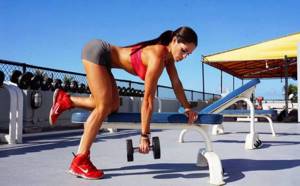
Before each workout, you should do several sets with an empty bar or light weight to warm up and improve your technique.
Cold muscles and tendons are more susceptible to damage than warm and stretched ones.

You need to eat right, maintaining a balance of all micro and macronutrients. Insufficient intake of vitamins from food can cause the development of various problems.

Therefore, if it is not possible to consume enough vegetables or fruits, purchase high-quality multivitamins that contain all the necessary minerals.

The speed of recovery directly depends on a person’s daily routine.
The release of anabolic hormones is associated with the time of day. The greatest secretion of growth hormone and testosterone is observed at night, so you need to get quality sleep.
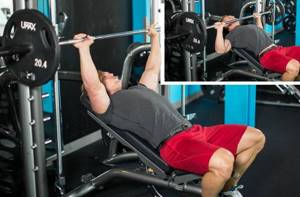
It is necessary to tune in well before each approach. This has a positive effect on the human nervous system, increasing impact and maximum tension.

Don't think about extraneous things during training. This may lead to a deterioration in performance technique.
Building a lesson
Any workout can be broken down into components. This is a warm-up, a working part and a post-workout cool-down. Also below is an example of a three-day split program.
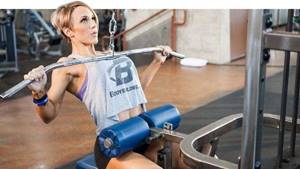
Even if you train one or two zones, you need to warm up your whole body before exercise. Warm up for 5-7 minutes. You can work out on a cardio machine or perform a standard joint warm-up, which many remember from school physical education lessons (circular rotations with arms and legs, head turns, mill, squats, etc.).
Main part
To begin with, here are the general principles of doing the exercises.
- To tone muscles and maintain shape for each part of the body, it is enough to do 3-4 exercises of 12-15 repetitions in 3 sets. Choose a medium weight to feel the load. Rest between sets is 40–60 seconds, and between exercises – 1.5 minutes.
- For girls who are working on body definition and losing weight, it is recommended to work with small weights with a higher number of repetitions (15–20, in some exercises can be increased to 20–25). In this case, the pace should be kept slightly above average, and the rest between exercises should be reduced if possible.
- When working on mass, on the contrary, you need to increase the working weight to close to the maximum (for beginners to slightly above average), reducing the number of repetitions to 8–12. You should rest 60–90 seconds between sets and 2.5 minutes when changing exercises.
The cycle phase is important in girls’ training. At the beginning of the month, you can increase the load, try new exercises and devote more time to aerobic exercise.
In the second half of the cycle, it is worth giving the body a rest from intense exercise and, if you feel unwell, reduce weight or reduce repetitions.
Example program
The following program is provided as an example. You can make changes to it in accordance with your individual characteristics - work schedule, favorite exercises and level of training.
Day 1: legs/buttocks and abs
- Squats with a barbell or bodybar (for beginners). Wide stance of the legs, toes pointing diagonally.
- Lunges with dumbbells.
- Romanian style deadlift (Romanian deadlift).
- Calf raises in a machine or with dumbbells.
- Hanging leg raises for abs. Perform as many repetitions per set as you can.
- Twisting the body on an incline bench.
- Plank. Try to increase the time spent in the plank pose from 30 seconds to 2 minutes per approach.
Day 2: back and biceps
- Pull-ups. If you can’t do a single pull-up, use negative reps. That is, you rise to the top point by standing on a pedestal or bench, and from there you slowly lower your body using the muscles of your back and arms. Do as many repetitions as you can.
- Pull of the upper block behind the head.
- Barbell row to the stomach.
- Row a dumbbell to the waist with each hand alternately. We count the number of repetitions and approaches for each hand.
- Hyperextension.
- Curling arms with dumbbells for biceps.
Day 3: Chest, Triceps, Shoulders
- Push-ups with wide arms. If you cannot perform the required number of times, simplify the exercise by standing on your knees.
- Dumbbell bench press.
- Dumbbell raises.
- Standing overhead dumbbell press.
- Standing dumbbell lateral raises
- Reverse push-ups.
- Extension of arms for triceps in a block simulator.
Finishing the session and stretching
For girls who want a toned and slender body, final stretching is very important. It helps relax muscles and calm breathing. Skipping stretches will lead to severe muscle pain the next day. If you sabotage stretching regularly, the muscles will become stiff and the likelihood of injury will increase. You can use a short yoga routine or classic stretching movements.

On average, each split workout takes from 30–40 minutes to an hour. The duration depends on how long you rested between reps and exercises.
Split is ideal for those girls for whom circuit training is not enough to get the desired results. The program can be compiled independently or with the help of a trainer. Due to the fact that only certain muscle groups are worked out in one session, the workout will not take much time and will be very intense.
Types of splits in bodybuilding
There are a lot of split programs, we will look at the basic types:
- Two-day bodybuilding training. Not the best option. The essence is the division of the body into “bottom and top”. For example, on the first day the chest, back and arms are pumped, on the second – legs and abs. The disadvantage is that in one lesson you have to work with several large groups. If you still choose this path, then limit the number of approaches and focus on the muscles (pectorals, lats).
- The three-day split is one of the most common types of splits in bodybuilding. The key concept of the exercises is deadlifts and presses. Here the body is divided into 3 parts. For example, one group is the shoulder girdle, triceps and back, another is the biceps and chest, the third is the abs and legs. You can combine large groups with small ones to load muscle tissue as intensely as possible.
- A four-day split divides muscle groups according to the following principle: abs and legs, pectoral and triceps, back and biceps, deltoids and abs. Muscle groups can be divided into parts arbitrarily, at your discretion.
There are also the concepts of double (2 times a day) and triple split (3 times respectively). Both types are effective in preparing for bodybuilding competitions. An example of a triple type of split - in the morning large muscle groups are trained, in the afternoon - cardio training, in the evening - isolated work.
What is split training?
This program allows you to train specific muscle groups once a week. Accordingly, you can do quite a lot of exercises for these muscle groups in a short period of time and then, after a week, repeat them, but working with larger working weights, or in a larger range of repetitions, or you will progress by reducing the rest time between approaches or exercises etc. In general, each time you will complicate the task and train in such a style as to focus not on working all the muscles, but on specific muscle groups.
Split training comes in many different forms. For example, you can train antagonist muscles - for example, the biceps and triceps muscles of the shoulder (biceps and triceps). On a separate day you can train your legs. Thus, you can very efficiently focus on certain muscle groups and work them out quite efficiently and volumetrically.
Length of rest periods
In the split program scheme, you can also alternate the duration of rest pauses between exercises. The greater the load in the cycle, the longer pauses for rest you should allow yourself - 2 minutes or more. When the load is approximately 10 RM (that is, when the weight allows only the specified number of repetitions) or higher, smaller rest pauses can be used - in the range of 30-60 seconds. Shorter rest periods at 10RM will result in greater metabolic responses and greater release of anabolic hormones, including growth hormone.
The duration of rest pauses can be cycled like other changes (intensity or volume of training). The goal is to prepare different exercise regimens that differ from each other and activate metabolic and endocrine processes.
Weekly split training process
Our split is divided into 5 parts - legs, back, chest, shoulders and arms. You can train 5 times a week, or 4 or 3. In the latter cases, you will simply have to combine the load. For example, in one training session you can work out your back and shoulders, or your legs and chest at the same time. It all depends on the characteristics of your body and desire. Here you should follow the rule - at the beginning of the lesson you should train a large muscle group, at the end - a smaller one.
A weekly training program is an excellent training scheme that allows you to “break down” muscle groups so that you have time to work out each of them in one round (week).
Here is the actual split to mass:
Leg press (medium leg position) – 10 times Deadlift – 10 times Leg extension in the machine – 20 times Leg curl in the machine – 10 times
Recommendations for leg training:
- Exercises are performed one after another, without rest.
- A superset for mass is performed in 3 circles, with a rest of 60 seconds between them.
Vertical block row – 4*8-12 times Bent-over barbell row – 4*8-12 times Bent-over dumbbell row with one arm – 4*8-12 times Horizontal block row to the waist (narrow grip) – 3-4*10-15 times
Tips for training your back according to a weekly program:
- As a warm-up before training, you can do pull-ups on the horizontal bar.
- Before the main work, perform 1 warm-up set.
- Rest 60 seconds between sets, 90 between exercises.
- In the last sets of mass, you can use cheating.
Lying dumbbell flyes – 2*12-15 times Lying dumbbell flyes – 3*8-12 times Dips – 3*10-20 times Lying down press – 3*5-15 times Crossover raises – 2*20 times
Recommendations for working out the chest:
In extreme approaches to mass work, it is important to achieve muscle failure; for this, increase the weight from set to set. Do this in such a way as to remain within the permissible repetition range and, of course, without compromising technique.
Bench press from behind the head – 4*8-12 times Seated dumbbells – 4*8-12 times + drop set Raising the barbell to the chin – 3*8-12 times Dumbbell swings to the sides – 3*8-12 times + super set (12kg-16kg-18kg) Arm abduction in crossover – 4*10-15 times
Tips for splitting deltas according to a weekly scheme:
- Use super and drop sets, negative and forced reps, basically anything that will help you achieve muscle failure. When doing bench presses, it is better not to use such techniques - this is traumatic for the joints.
- Be sure to stretch your deltoid muscles between sets.
Barbell curls for biceps – 5*6-12 times, start cheating from the 4th set. Lifting the barbell on a Scott bench – 4*6-12 times. Concentrated curls for biceps – 3-4*6-12 times. French bench press – 4*6. -12 dips on parallel bars – 3-4 approaches to failure
Recommendations for pumping up your hands:
Gradually increase the weight on the bar. But be careful when training your triceps with heavy weights, you can get injured.
Two-day split for mass
There are many training programs for any occasion, as they say, and what suits one person does not necessarily have to be effective for another. Everyone’s body reacts to stress differently, but as with everything, there are rules that, as we know, only confirm the exceptions. The three pillars of bodybuilding that everyone knows about, even people who have crossed the threshold of the gym for the first time are nutrition, regular training and time to rest. My trainer told me, a young bastard: “Nutrition is a very important part of development, one might even say that it is more important than training.
Skipping one meal is worse than missing one workout. But it's better not to miss anything. With rest, the situation is as follows - muscle mass is very timid, so it restores itself only during passive rest in complete peace or on the sofa while sleeping. A two-day split in bodybuilding promotes growth, because while the back and biceps are resting, the chest and triceps are working, and vice versa.
Mass training is nothing more than stimulating the growth of muscle mass by breaking muscle fibers with subsequent increased growth. This is achieved through difficult and exhausting exercises using the maximum possible permissible mass of free weight or weight in the simulator. In human language - we puff and sweat, we lift weights to the limit, but not everything is so rosy. The human body needs rest in the form of sleep, quiet wakefulness and active rest.
Stressful influences, whether physical exertion to the limit of strength or mental, cause certain kinds of consequences. In our case, physical activity affects the body through excessive stimulation and loss of energy. Losses are replenished with the intake of food and in passive rest during sleep.
Mass split is a good training option; the principle can be taken as a basis for building a training schedule for individual data. One day of training involves several energy-intensive exercises, which are started at the beginning of the workout, and easier ones. It is also convenient to divide into workable zones
It is necessary to remember about nutrition - an important aspect of the program; large strength loads require additional calories

Example program No. 1
- Squats.
- Squats in Hack.
- Squeezing weights with your legs while lying in a machine.
- Lunges.
- Leg extension and flexion.
- Calf raises for the calf group.
- Lifting weights from the chest on a flat bench.
- Hand raises in the butterfly simulator.
- Bent-over barbell push-up.
- Working in Hummer.
- French press.
- Lifting with a narrow grip straight bar.
- Raising dumbbells from behind your head.
- Pullover.
One day to rest.
- Romanian cravings.
- Lying leg curl.
- Leg squeeze in Hack.
- Leg bending in the simulator.
- Army press.
- Dumbbell raises.
- Arnold press.
- Shrugs.
- Raising your arms with dumbbells forward.
- Deadlift. (Be sure to read and watch all the details here)
- Pull of a vertical block behind the head.
- Horizontal block thrust.
- Bent-over barbell row.
- Pull-ups.
- Close grip pull-ups.
- Wide grip barbell curl.
- Hammers.
- Crossover arm curl.
Example of program No. 2 for ground
At its core, program No. 2 for mass differs only in details - in order to achieve the goal and reach the muscles that do not want to strain, you need to approach the same set of exercises from a different angle. It is known that there are more than one or two exercises for each muscle area. This is precisely the essence - to work out muscle mass, forcing all the muscles of this group to take part in the work.
As a rule, exercises of this kind are called isolating exercises. From the name it is clear that with this approach to training, the muscle works separately from others, allowing you to work on relief during drying or force a group to work that is difficult to fit into a standard training plan.
Important! It is better to start strength training with a warm-up to get the blood flowing; we train the large muscle first, then the medium and smaller ones. Some people think that it’s not worth spending time on abs, because
it works statically with other muscles. When performing deadlifts, squats, i.e. All possible options for performing exercises in which there is at least a slight probability of spinal injury, it is necessary to strictly follow the execution technique in order to avoid injuries and their consequences.
Split programming
Since the body has proven to respond better to full-body training instead of isolating the upper and lower parts in separate sessions, the concept of a split program style has begun to make more sense to bodybuilders.
The characteristics of split programs that are unique and different from typical split workouts are:
- Workouts are planned in which exercises for the upper and lower parts of the body are performed in one session, but the angles of impact of the exercises are changed so as to allow the previously worked muscles to rest;
- Each training session uses a powerful multi-joint exercise to create a central physiological stimulus for growth and metabolic activity throughout the body.
Training regimens using split programs are a huge help for many athletes. They can provide the same time savings and provide stimulation of both localized muscle tissue and central reactions of the entire body.
What conclusions can be drawn?
If you want to achieve any results, you shouldn’t rush into the pool headlong. You need to start everything gradually and correctly, gradually approaching a four-day split. Since this is a very important, difficult training. If you start doing it, you shouldn’t stop halfway.
In the end there will be no result. Therefore, before starting any training, you should make sure that you do not quit what you started. To achieve the desired results, you need to follow all the rules. Only in this case the desired effect will be achieved.
And before you start serious training, you need to consult a doctor to make sure that your health will not let you down. After this, it is better to discuss your training program with an experienced trainer. He will tell you how best to group muscles and create a program. Only after this can you safely start training.


